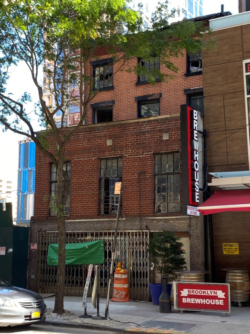
Harriet and Thomas Truesdell House Image Credit: LPC
The designation retains its historical significance despite having alterations. On February 2, 2021, the Landmarks Preservation Commission voted unanimously to designated the Harriet and Thomas Truesdell House as an individual landmark. The house, located at 227 Duffield Street in Downtown Brooklyn, recognizes abolitionists Harriet and Thomas Truesdell and the City’s abolitionist movement. For CityLand’s prior coverage of this designation process, click here.
Harriet and Thomas Truesdell had done prior abolitionist work in Rhode Island before settling in Brooklyn. In the years leading up to the Civil War, the Brooklyn waterfront was an entry point for many people escaping slavery in the south. The Truesdells lived at the home from 1851 to 1863, during which the Fugitive Slave Law required more clandestine abolitionist activity to avoid harsh penalties for aiding escaped slaves. Stories out of oral history claim that the house may have even been used as a stop on the Underground Railroad; although Landmarks could not confirm this, the necessity of secrecy of abolitionist actions because of the Fugitive Slave Law could explain the lack of documentation to confirm the stories. Whether the house was a stop on the Underground Railroad or not, the house was still the home of two prominent abolitionists and recognizes the City’s abolitionist movement.
The building is a Greek revival style row house built between 1847 and 1850. A two-story commercial extension was added to the building in 1933, but the building retains its 19th century form and historical significance. Above the extension, the building’s original 1850s facade, window surrounds, cornice and fenestration pattern can be seen.
Landmarks Chair Sarah Carroll stated, “The Landmarks Preservation Commission is committed to telling the story of New York City’s African-American heritage and experience and is prioritizing designations like the Harriet and Thomas Truesdell House as part of its equity framework. The Harriet and Thomas Truesdell House represents the important role the city played in the efforts to abolish slavery. The Truesdells were active abolitionists during a decisive period of resistance and their legacy of commitment is representative of the many abolitionists who supported total emancipation as part of the local and national movement.”
Brooklyn Borough President Eric Adams stated, “Few New Yorkers know that a small rowhouse in Downtown Brooklyn was a critical site in our nation’s history – a place where abolitionist thought flourished, and a safe harbor for slaves on their long sojourn to freedom. That’s why months ago, we joined a campaign to preserve the historical integrity of 227 Duffield Street – to show that the Black lives of freedom-seekers mattered, and still matter to this day. At a time when our nation continues to face a reckoning over the long and painful legacy of racial injustice, remembering and permanently enshrining these pieces of our history has never been more urgent. We thank the Mayor and the LPC for recognizing the significance of this site, and the need to preserve it for future generations.”
By: Veronica Rose (Veronica is the CityLaw fellow and a New York Law School graduate, Class of 2018.)

